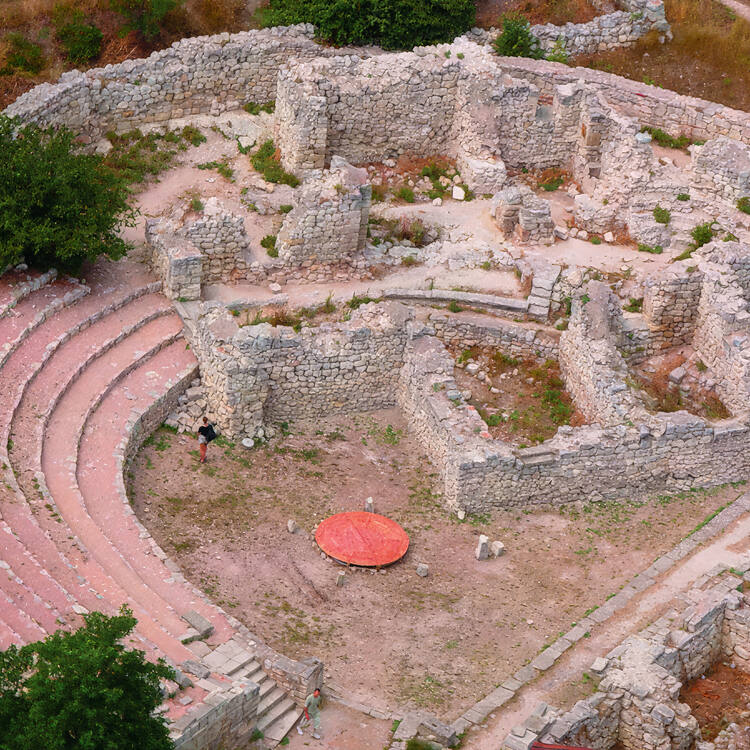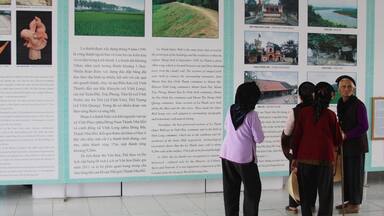Ancient City of Tauric Chersonese and its Chora
Ancient City of Tauric Chersonese and its Chora
The site features the remains of a city founded by Dorian Greeks in the 5th century BC on the northern shores of the Black Sea. It encompasses six component sites with urban remains and agricultural lands divided into several hundreds of chora, rectangular plots of equal size. The plots supported vineyards whose production was exported by the city which thrived until the 15th century. The site features several public building complexes and residential neighbourhoods, as well as early Christian monuments alongside remains from Stone and Bronze Age settlements; Roman and medieval tower fortifications and water supply systems; and exceptionally well-preserved examples of vineyard planting and dividing walls. In the 3rd century AD, the site was known as the most productive wine centre of the Black Sea and remained a hub of exchange between the Greek, Roman and Byzantine Empires and populations north of the Black Sea. It is an outstanding example of democratic land organization linked to an ancient polis, reflecting the city’s social organization.
Description is available under license CC-BY-SA IGO 3.0
Cité antique de Chersonèse Taurique et sa chôra
Il s’agit des vestiges d’une cité fondée au 5e siècle avant J-C par les Doriens sur les côtes nord de la Mer noire. Le site comprend six parties correspondant aux vestiges de la cité et à l’arrière-pays agricole divisé en plusieurs centaines de chôra, des parcelles rectangulaires de taille égale. Dans ces parcelles se pratiquaient une viticulture dont la production était exportée par la ville. Ce commerce a perduré jusqu’au 15e siècle. Le site comprend plusieurs bâtiments publics, des quartiers résidentiels, ainsi que des monuments chrétiens du début du christianisme, des restes d’établissements de l’âge de pierre et de l’âge du bronze, des fortifications romaines et médiévales, des systèmes d’alimentation en eau et des exemples très bien préservés de culture de la vigne et de murs de séparation. Au 3e siècle avant J-C, l’endroit était considéré comme le plus productif centre viticole de la Mer noire et il est longtemps resté un nœud commercial entre les empires grec, romain, byzantin et les populations du nord de la Mer noire. Il s’agit d’un exemple remarquable d’organisation démocratique des terres associé à une polis antique, reflétant l’organisation sociale au sein de la cité.
Description is available under license CC-BY-SA IGO 3.0
Ciudad antigua del Quersoneso táurico y sus "chôra"
source: UNESCO/CPE
Description is available under license CC-BY-SA IGO 3.0
古代都市「タウリカのヘルソネソス」とそのホーラ
古代交易で繁栄を謳歌した都市遺跡。古代ギリシャでは、現在のクリミア半島はタウリカ半島と呼ばれ、ヘルソネソスは、紀元前5世紀にドリス人が半島南西部に築いた植民都市である。都市部のポリスとホーラと呼ばれる区画された後背農地からなり、古代の景観をとどめる稀有な例。都市の遺構として重要なのは、前5世紀から後13世紀の間に形成された直交する街路システムで、市域外も含めて現在も400カ所の区画が残る。2000年にわたってクリミアとスキタイを含むギリシャ北東交易圏の拠点だったことから、地域の中核都市の例としても貴重である。source: NFUAJ
Oude stad van de Taurische Chersonesos en haar chora
De Oude stad van de Taurische Chersonesos werd in de 5e eeuw voor Christus gesticht op de noordelijke oever van de Zwarte Zee door Dorische Grieken. Het erfgoed omvat zes gebieden met stedelijke resten en landbouwgronden verdeeld in honderden chora – rechthoekige percelen van gelijke grootte. Deze dienden voor wijngaarden en in de 3e eeuw na Christus was het gebied het meest productieve wijncentrum van de Zwarte Zee. Er zijn openbare gebouwen en residentiële wijken te vinden, evenals vroegchristelijke monumenten en overblijfselen van nederzettingen uit het Stenen en Bronzen tijdperk. Verder kent het gebied Romeinse en middeleeuwse vestingwerken en watervoorzieningen en goed bewaard gebleven wijngaarden en scheidingswanden.
Source: unesco.nl
Outstanding Universal Value
Brief synthesis
Tauric Chersonese and its chora are the remains of an ancient city, founded in the 5th century BCE as a colonial settlement of the Dorian Greeks, located on the Heraclean Peninsula in south-west Crimea. The polis and extended chora of Tauric Chersonese form an outstanding example of an ancient cultural landscape, consisting of a Greek polis and its agricultural hinterland established as part of colonist activities in the 4th and 3rd century BCE. The significant archaeological ruins of the city retain physical remains constructed between the 5th century BCE and the 13th century AD laid out on an orthogonal grid system. The basic orientation of this orthogonal grid continues into the wider landscape where fragments of a vast land demarcation system of 400 equal allotments in an area of 10,000 hectares have been preserved.
The Ancient City of Tauric Chersonese and its chora is an exceptional example of a peripheral centre of movement of people which acted as an important gateway to the north-eastern parts of the Greek trade influence, including the Crimea and the Scythian state. The city maintained its strategic role over almost two millennia and provides a unique example for the continuity and longevity of a mercantile outpost connecting the different Black Sea trade routes.
Criterion (ii): Tauric Chersonese provides an outstanding physical testimony to the exchange that took place between the Greek, Roman and Byzantine Empires and the populations north of the Black Sea. The polis and its chora stand out for having retained this role as a centre of exchange of influences and cross-fertilization between these cultures for a very long time and with continuity over millennia.
Criterion (v): Tauric Chersonese and its Chora represents a relict agricultural landscape of a vast and, at locations, well-preserved land allotment system, of formerly over 400 equal allotments connected to a preserved polis. The remains of the division walls, fortifications, farmsteads and the characteristic grid layout embodied the lifestyles of the city’s inhabitants and illustrate the agricultural use and continuity of the landscape despite later changes in production.
Integrity
The six property components include the complete ancient polis of Tauric Chersonese as well as fragments of its chora. About half of the chora has been lost due to urban development and yet, only small parts of what remains have been inscribed. This selection provides a sufficient fragment of the chora landscape, but a future expansion of the property to include further chora segments would be desirable and would further strengthen the integrity of the property.
The impact of urban development on the chora setting is significant and the integrity of the wider landscape is fragile and requires decisive and consistent protection and planning mechanisms to prevent further negative impacts by insensitive urban or infrastructure developments. Likewise, the city of Tauric Chersonese has experienced significant developments of intrusive character, some of which have been committed to be relocated.
Authenticity
The condition of authenticity in material, design and substance is good for the archaeological remains of the polis and the chora. About 10 of the 40 hectares of the site of Tauric Chersonese have been excavated leading to a good understanding of the history and development of the town. Less excavations have taken place in the chora but its structure and layout is nevertheless well understood. No major restoration or conservation projects were carried out with the exception of a few cases of anastylosis. This has retained high degrees of authenticity in material and substance. Authenticity in form and design is well retained in its relations to the urban layout and chora plot division.
The authenticity in setting and location is partly affected, predominantly by the 20th century constructions which destroyed parts of the ancient city but also by urban encroachments and infrastructure projects close to the chora sites. Their impact could be reduced to the extent possible by removing the yacht club and associated structures from its present location and better integrating the cathedral within the archaeological site.
Management and protection requirements
The property enjoys the highest level of national protection according to the Law of Ukraine on Cultural Heritage Protection (No. 2518-VI of 9 September 2010). This status prohibits any activities within the boundaries that may have any negative impact on the state of preservation, or use of any cultural heritage sites and designated monuments. A recently launched project entitled “Boundaries and land use regimes for the protected areas of the monuments of the Tauric Chersonese National Preserve located on the territory of the Heraclean Peninsula in the City of Sevastopol” aims at integrating a more sophisticated zoning and protection concept in the Master Development Plan, which would strengthen the protection status of the extended chora landscape. The official adoption of the draft plan should be given priority.
The authority responsible for the property is the Tauric Chersonese National Preserve which was mandated as the management agency by the Ministry of Culture. Key protection challenges of the property are erosion, in particular shore erosion, the establishment of adequate security measures on all site components and urban development. Urban development has in the past been and will continue to be a key risk as the city of Sevastopol is located at very close distance to the archaeological sites and continues to grow. Inappropriate urban expansions will negatively impact the already fragile integrity of the archaeological landscape. Important works are underway to integrate the archaeological landscape into the wider land-use and protection system. These have to be finalized to cover a wider area beyond the presently designated protected areas and landscape protection zones. Future inclusion of these features through boundary extensions of the property would ensure that the relict landscape of the Chersonese chora could be protected in its larger context.
A revised management plan which is to be finalized in mid 2013 should be officially adopted and management priority should be given to conservation needs. In view of the critical state of conservation of the ruins in the city of Tauric Chersonese, some of which are highly dilapidated or even close to collapse, budgetary resources need to be increased to respond to the urgent conservation and security challenges. Clear budgetary priority needs to be given to conservation and visitor security rather than interpretation and other tourism projects.




